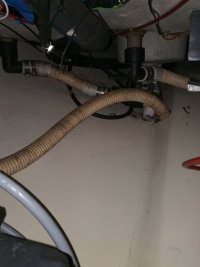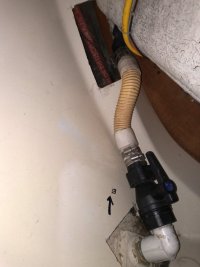I started replacing all my cockpit scupper drain hoses the summer--the old, dried-out corrugated hoses weren't leaking but were very brittle and probably long overdue for replacement. So, the overall goal was to replace the old corrugated hoses, and to eliminate the PVC elbows if possible. As usual, nothing was as simple as it seemed.
 Starboard
Starboard 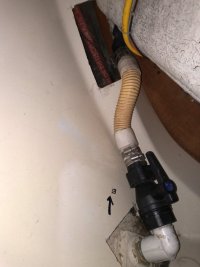 Port
Port
On the starboard side, the distance and angle between the scupper and the through-hull was enough that I was able to make the connection with flexible 1.5" sanitation hose. Also, the vertical drop between the two was enough to allow me to move the Forespar ball valve directly to top of the through-hull. This was a win-win: It got rid of the PVC elbow and also provided a direct NPS-to-NPS thread match between the ball valve and through-hull.
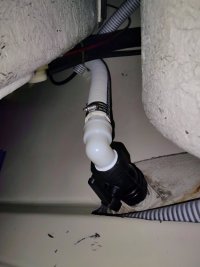
The port side was trickier. Here, I didn't want to mount the Forespar valve on top of the through-hull (as I did on the other side) because I want to add a winterization drain to the center-cockpit drains (which tee together to drain below the galley sink). So, I swapped out the PVC elbow for a bronze elbow that I had custom-drilled/tapped to accept an additional drain line. But, because of the short distance & angle between the scupper and through hull, I couldn't find ANY type of solid hose that would bend or compress enough to fit between the two hose barbs. So, I remounted the bronze elbow about 45 degrees counter-clockwise from its original position. This allowed my to span the two hose barbs with a 90 degree and a 45 degree silicone hoses spliced together. I don't know what the consensus/ABYC opinion is on silicone hose is, but it seems to be quality stuff.
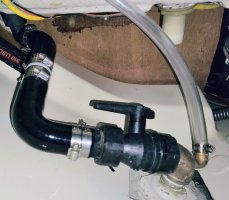
Next up is the center-cockpit drains....
 Starboard
Starboard  Port
PortOn the starboard side, the distance and angle between the scupper and the through-hull was enough that I was able to make the connection with flexible 1.5" sanitation hose. Also, the vertical drop between the two was enough to allow me to move the Forespar ball valve directly to top of the through-hull. This was a win-win: It got rid of the PVC elbow and also provided a direct NPS-to-NPS thread match between the ball valve and through-hull.

The port side was trickier. Here, I didn't want to mount the Forespar valve on top of the through-hull (as I did on the other side) because I want to add a winterization drain to the center-cockpit drains (which tee together to drain below the galley sink). So, I swapped out the PVC elbow for a bronze elbow that I had custom-drilled/tapped to accept an additional drain line. But, because of the short distance & angle between the scupper and through hull, I couldn't find ANY type of solid hose that would bend or compress enough to fit between the two hose barbs. So, I remounted the bronze elbow about 45 degrees counter-clockwise from its original position. This allowed my to span the two hose barbs with a 90 degree and a 45 degree silicone hoses spliced together. I don't know what the consensus/ABYC opinion is on silicone hose is, but it seems to be quality stuff.

Next up is the center-cockpit drains....

